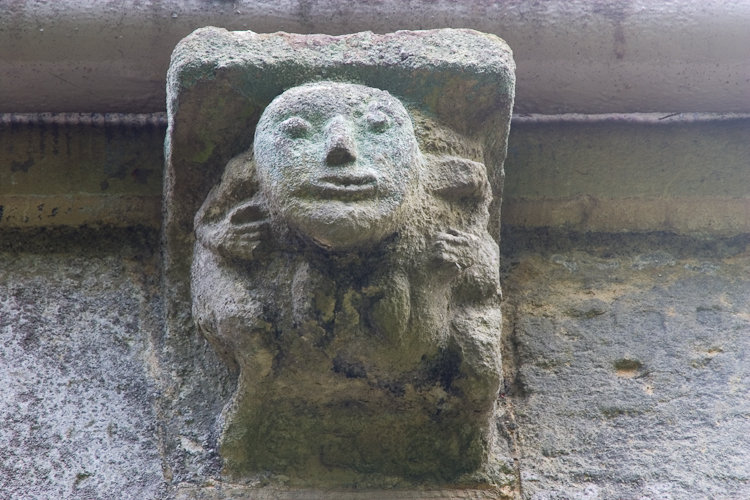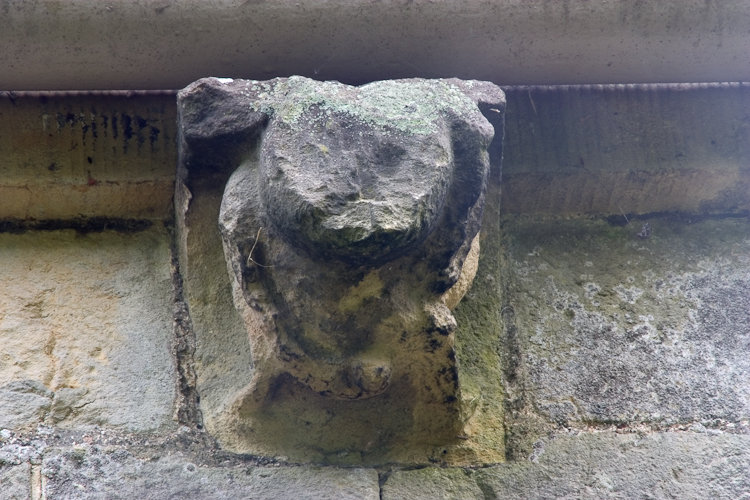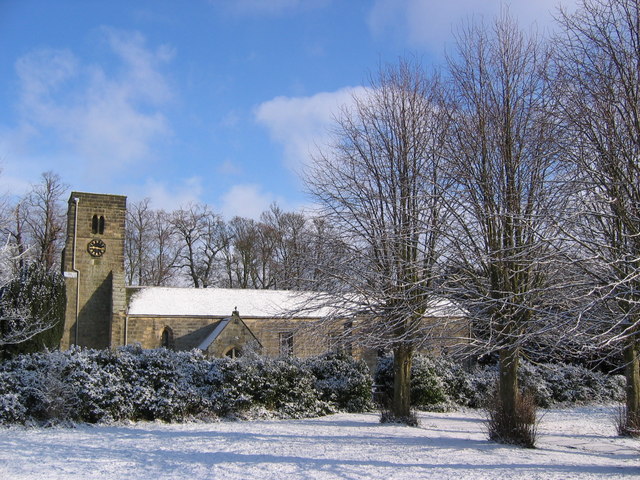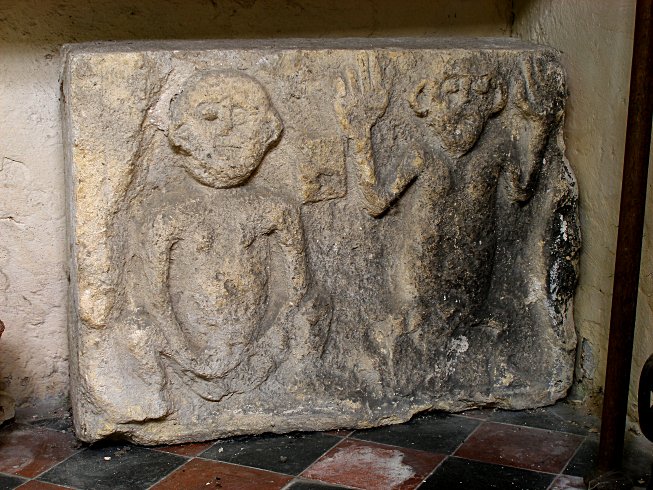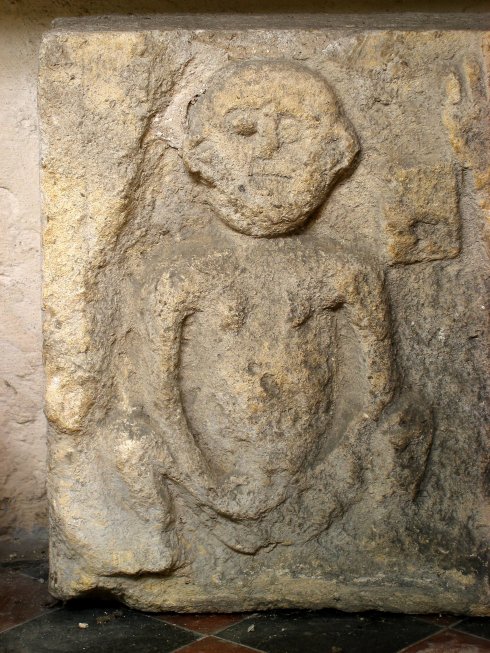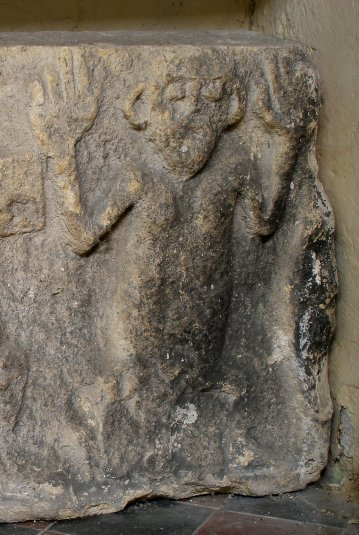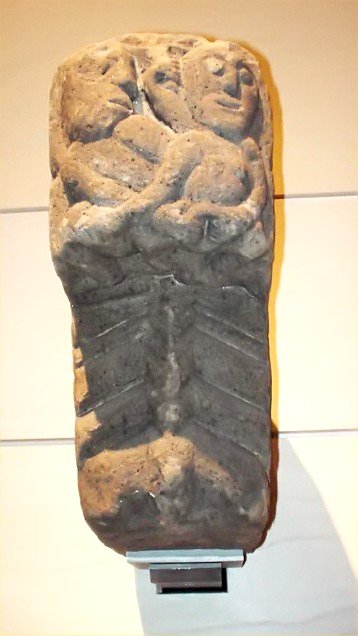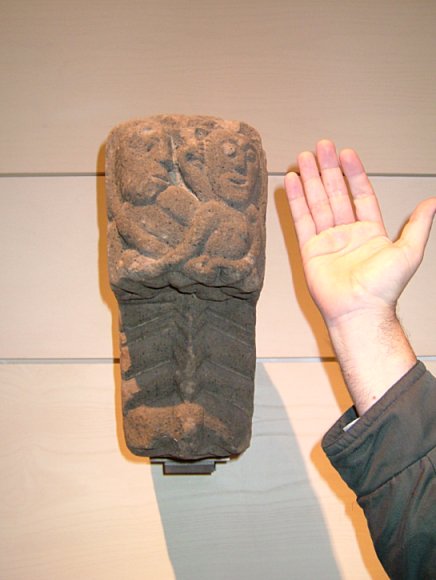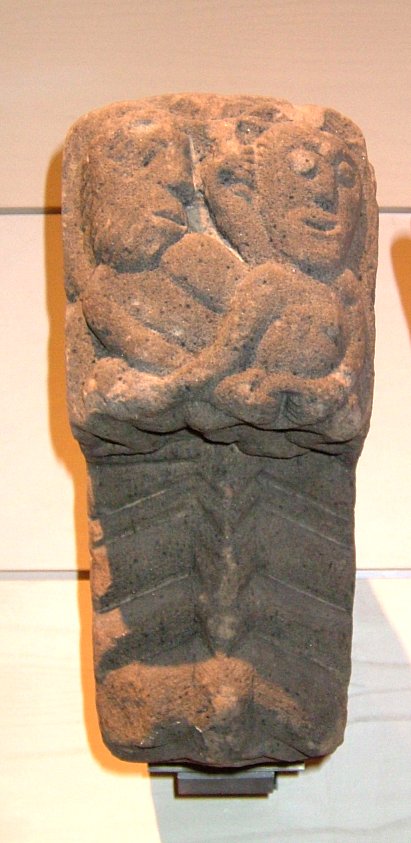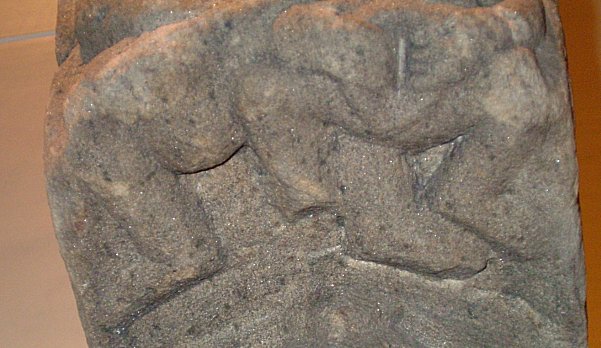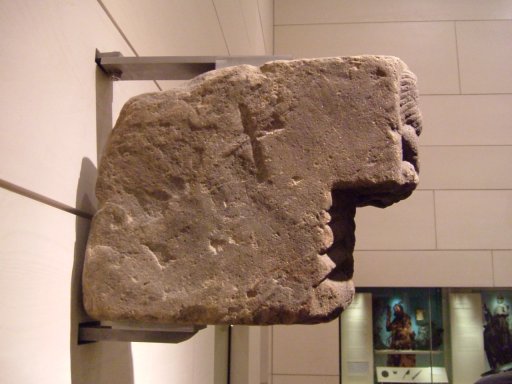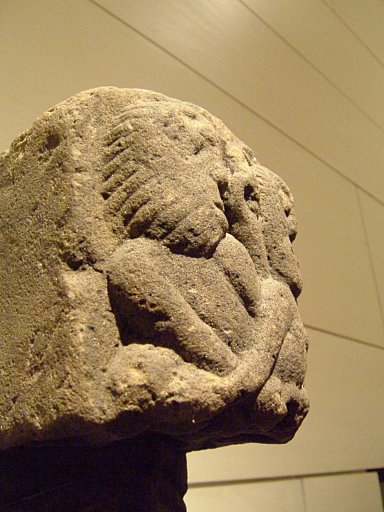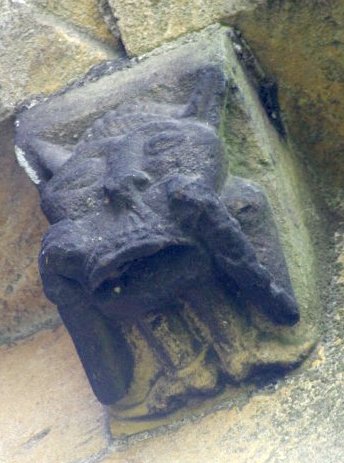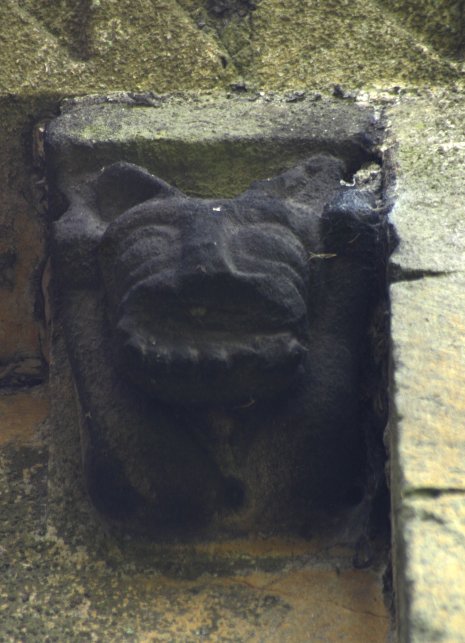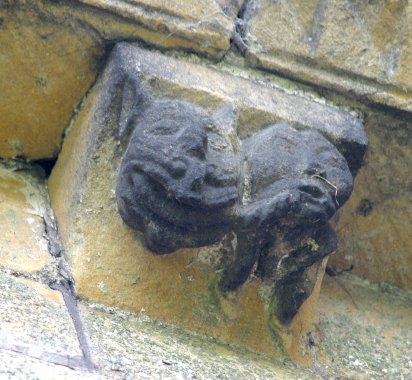Couple
Marienhafe, Germany
These male and female carvings date from the 13th century and reside in the tower Museum attached to the church of St. Marien in Brookmerland, East Frisia, Germany.
Both figures are spread legged with their hands on their knees and are unequivocally exhibitionist. One curious features is that they have their heads forward on the chest. This makes them look somewhat like Blemya figures. The female has small breasts located either side of its chin. Unfortunately the male figure was only on display as a drawing and has a modest set of genitals on display.
The present day church is a brick building which replaced the original church in 1829. The museum houses a collection of friezes and other sculpture from the remains of the 1829 demolition. As you can see from the lithographs below there are definite echoes of Romanesque style in the original church which makes the presence of the two exhibitionist figures more understandable.
All photographs used with the permission of the original photographer.
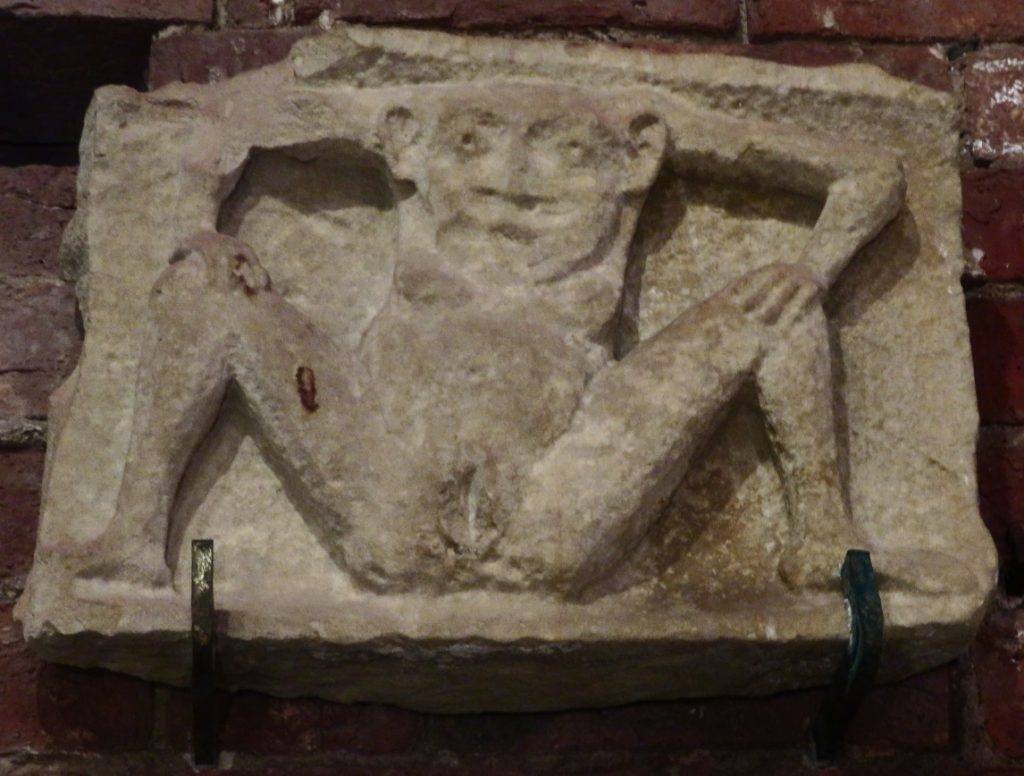
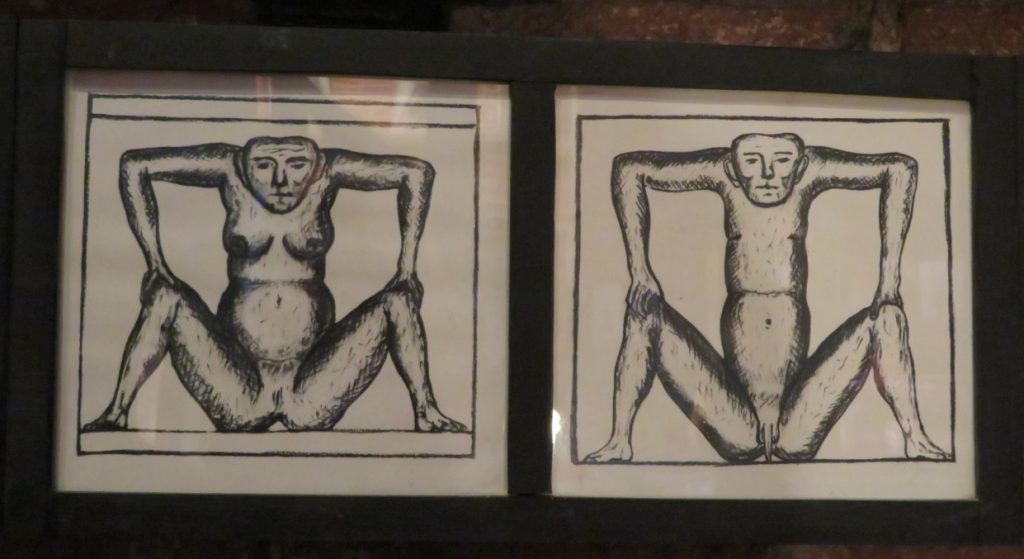
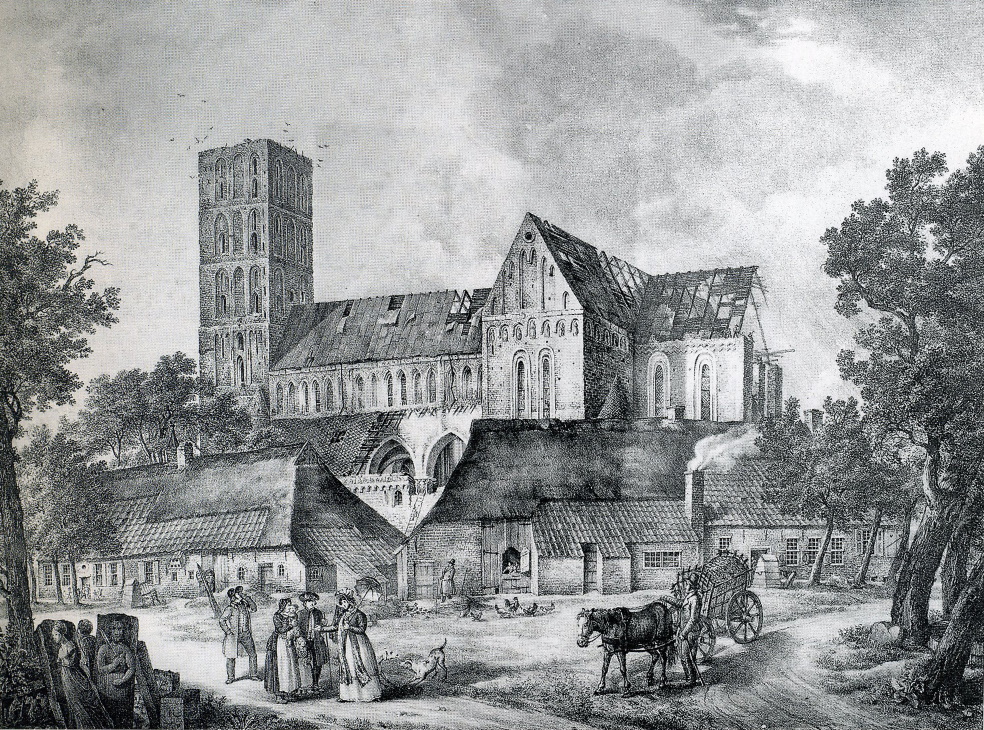
(Lithograph by D. Bendixen). There appear to remains of an older building in the middle of the image and there and some sculpture is still visible on the church. Note the sculptural gravestones in the bottom left hand corner. Image in public domain
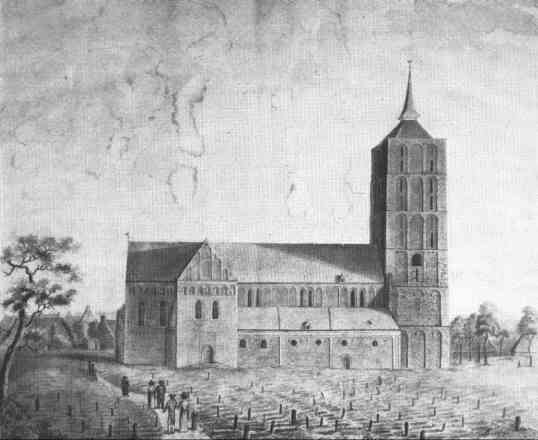
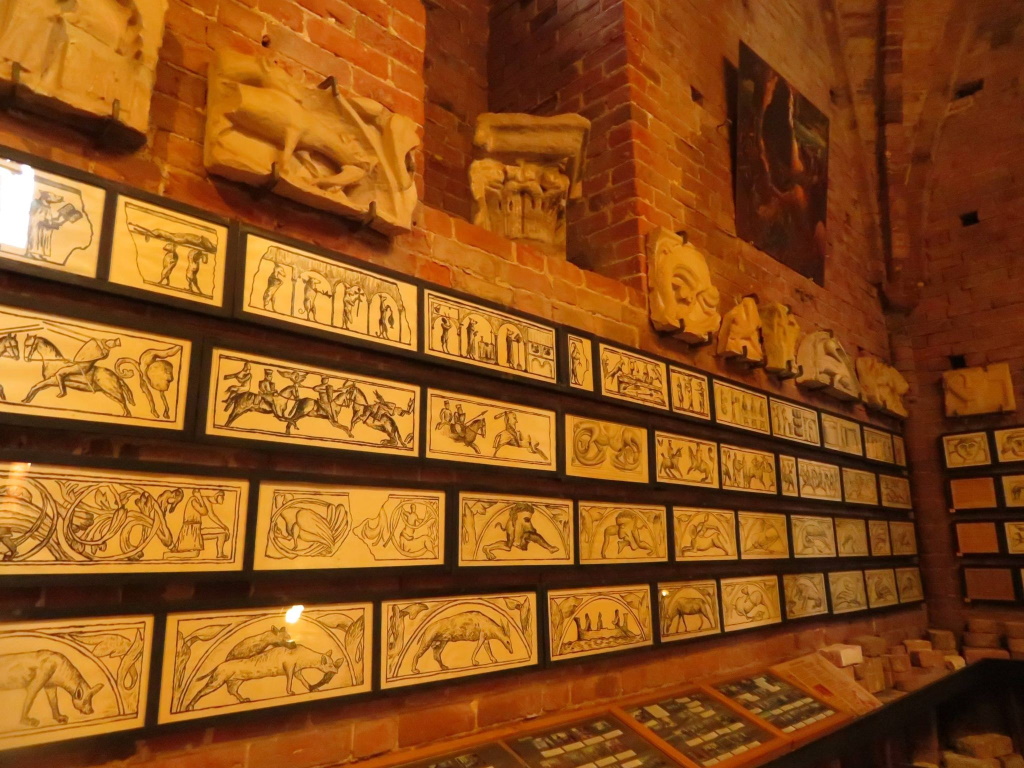
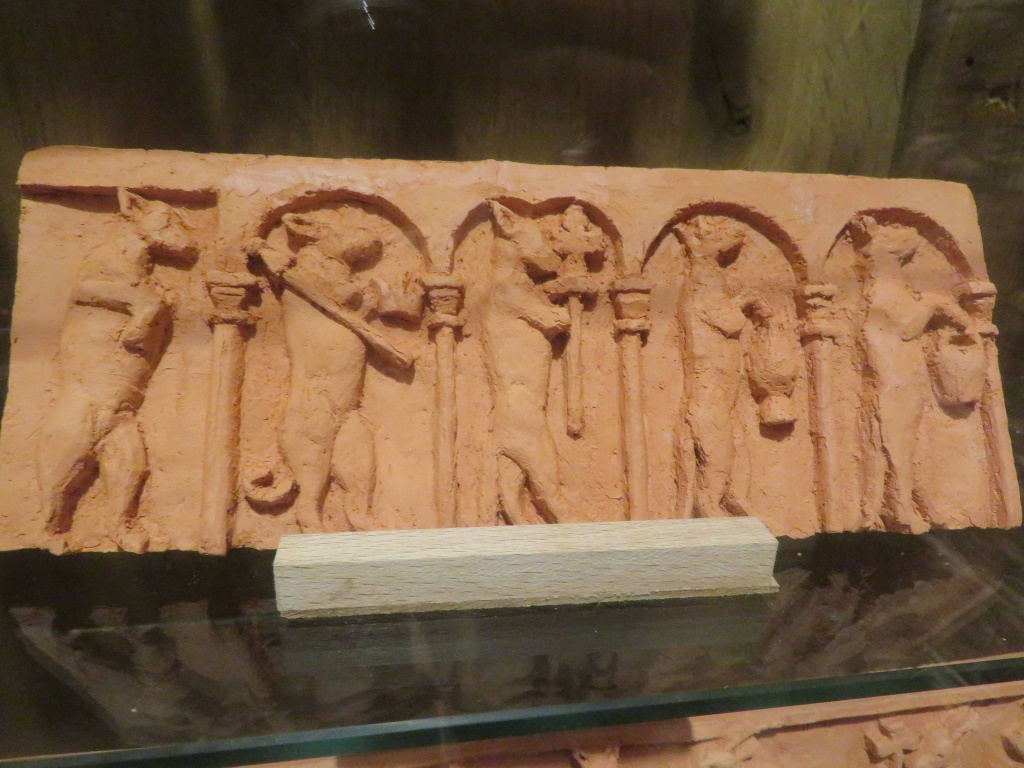
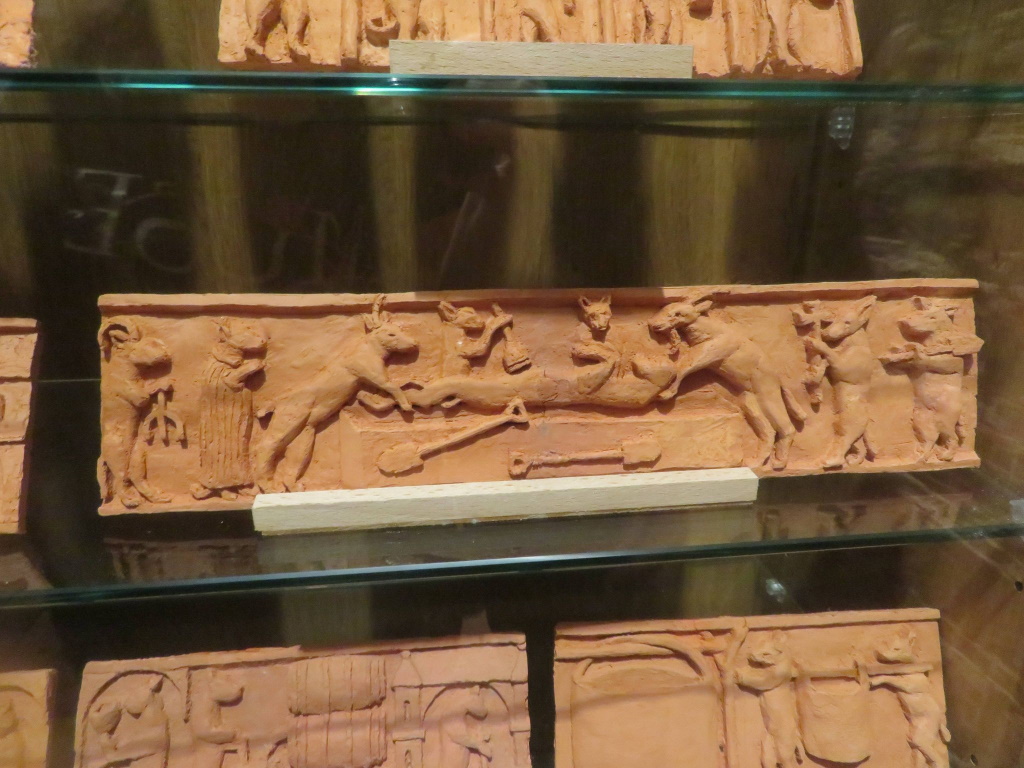
Access to the museum https://www.stoertebekerland.de/seite/372292/st%C3%B6rtebekerturm-marienhafe.html
Whittlesford
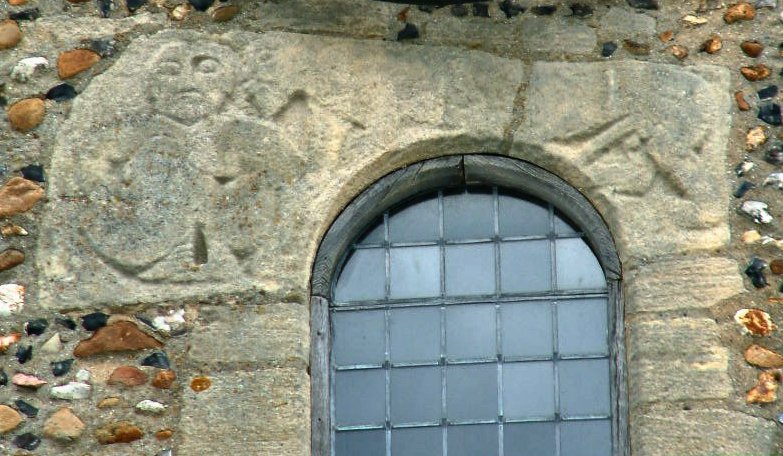
The Figures
This sheela can be found on the window arch directly below the clock on the tower of the Church of St. Mary and St. Andrew Cambridgeshire. Uniquely this figure is joined by a crouching phallic male figure which form the window arch. Interestingly this male figure is very much like figure that can be found at Abson near Bristol Avon even down the to position and orientation. The sheela figure itself has a deeply incised vaginal cavity which she holds open with one hand the other hand seems to be disappearing behind the leg of the male figure. One finger points to the clitoral area and there appears to be a slight suggestion of the clitoris at the top of the vagina. Both legs are held apart and the there appears to be a suggestion of breasts. The carving is not as clear as you might think and is not immediately visible from from below due to it’s height on the tower. In fact if you weren’t aware of it’s presence then you may not notice it’s existence. However once you do see the figure and it’s companion then the effect is quite shocking.
A Sexual Sheela
In the arguments over whether sheelas are sexual or apotropaic in nature this figure is often cited as evidence in favour of the sexual theory. It is hard to see anything other than a sexual meaning to this carving with the erect penis of the male figure and open vulva of the female. The elongated body of the male figure suggests a monstrous nature and so seems to add weight to the argument that this carving at least, is a warning against the sin of lust. It’s interesting to compare this figure to the Haddon Hall figure which seems to be equally unequivocally apotropaic in nature. These two figures show clearly that one theory does not explain all the figures.
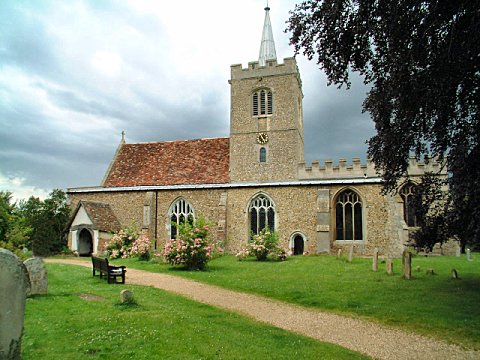
Location
North Grimston
The Church
The Church of St Nicholas at North Grimston North Yorkshire (Also known as North Grimstone)
The Village of Grimston lies 4 miles SE. of Malton in North Yorkshire is recorded in the Domesday book as “Grimeston”. The village is also known for the iron age sword accidentally found there in 1902. The Church of St Nicholas, on which the figure resides, has a number features which date it back to the Norman period but the font is widely regarded to be Saxon which dates the building back even further.
The Figures
The sheela is one of a number of Romanesque corbels some of which appear to be relocated voussoirs.The figure appears to be quite fat and unusually has a pair of pendulous breasts (see Oaksey for another example). There appears to be small cleft between the bent legs of the figure possibly indicating a vagina. The figure’s arms are held against the top of the chest. It’s quite modest in its exhibitionism, in some ways similar to the figure at Worth Matravers in Dorset. In fact a number of the figures bear a passing similarity to the carvings at Stoke Sub Hamdon and Studland far to the South. As well as the corbel table the church boasts a Romanesque chancel arch. This is another example of a figure which is not as unequivocally exhibitionist as say the Kilpeck or Oaksey sheelas yet still has sexual attributes (breasts in this case). It is interesting that this figure has a counterpart in masturbating male figure which seems to firmly put the carvings in the sexual sin category.
Pat O’Halloran’s site www.danu.co.uk has a number of photographs of the church, corbel table and its Saxon font. Thanks go to Pat for allowing the use of his images on this website.
Male figure at North Grimston
This figure while very worn can still just be recognised as a masturbating male figure with the remnants of a penis just visible. The motif can be seen at other Romanesque sites such as the Church of St John in Devizes and possibly at Tickhill Castle although the latter is very worn
![Creative Commons Licence [Some Rights Reserved]](http://creativecommons.org/images/public/somerights20.gif) © Copyright Stephen Horncastle and licensed for reuse under this Creative Commons Licence.
© Copyright Stephen Horncastle and licensed for reuse under this Creative Commons Licence.
Location
Northampton
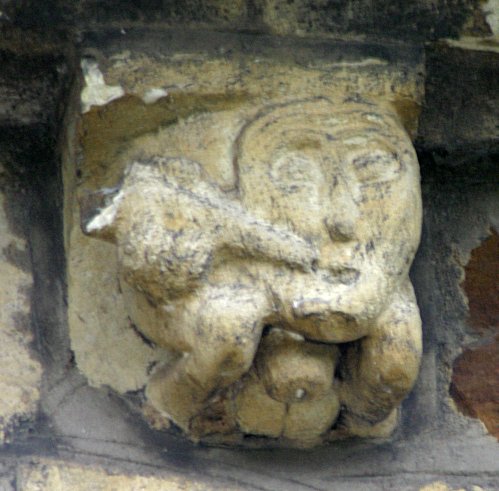
The Church
The church of St Peter in Northampton is a fine example of a 12th century church and more importantly for our purposes a veritable cornucopia of exhibitionist and near exhibitionist figures. This church has seemingly gone unnoticed in by most books on the subject despite being in the middle of one of Britain’s major towns. The church also holds an exhibitionist male being eaten by a monster on one of the capitals in the church. Unfortunately the church was locked when we visited it and I was unable to get a picture. Photos of the capital can be seen on the CRSBI site at http://www.crsbi.ac.uk/ed/nh/nhstp/i25307.htm and athttp://www.beyond-the-pale.org.uk/zxNorthampton.htm at Anthony Weir’s site. The exhibitionist corbels form part of a much larger corbel table which is detailed here http://www.crsbi.ac.uk/ed/nh/nhstp/ on the CRSBI site. There are many replacement corbels on church but all of the ones detailed below appear to be originals.
The Figures
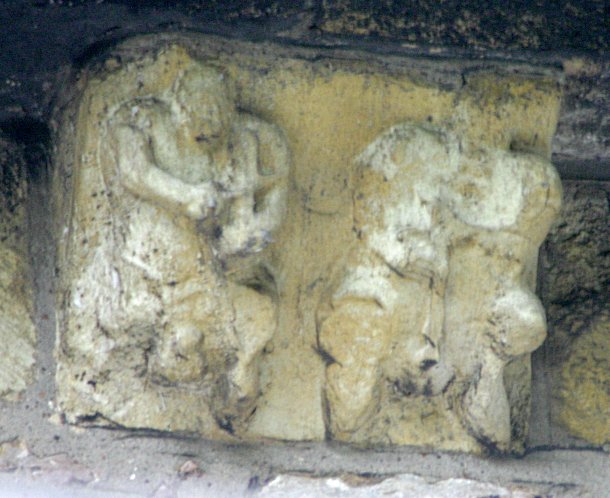
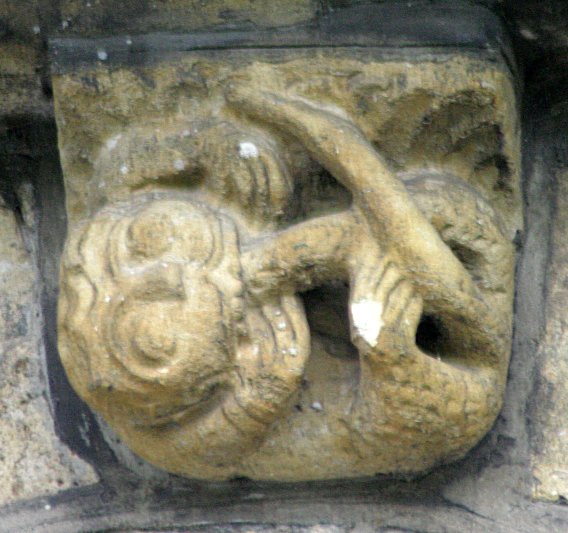
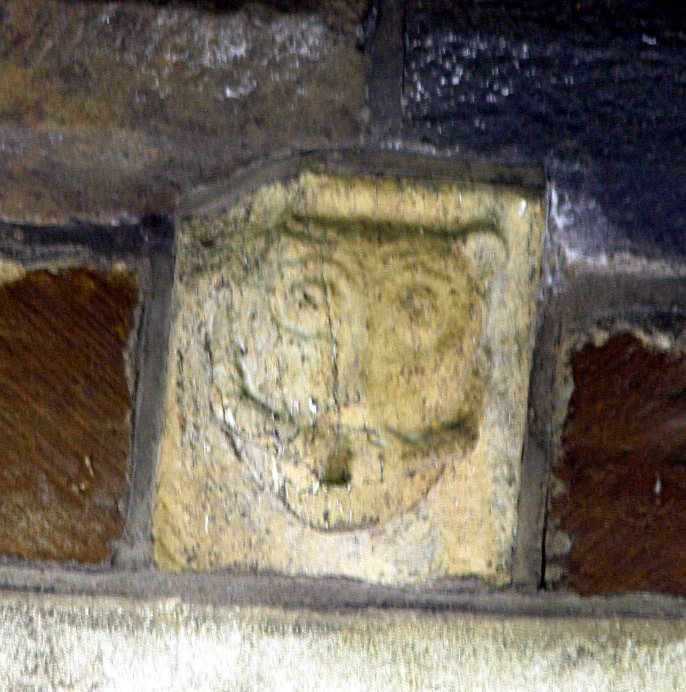


Location
Moulton
The Figures
These figures reside in the village of Moulton, Suffolk and were first reported by Dr Ron Baxter in the newsletter of the Corpus of Romanesque Sculpture in the British Isles. The sculpture consists of a loose slab which at the time of writing is stored in the vestry under shelf. It shows a male and female figure carved in relief with an ill defined square floating between them. Both figures are jug eared and the male figure’s hands are over large. The female figure’s hands gesture toward the groin which has been damaged at some point. what remains of the right hand appears to be cupped but this may jus be down to the damage on the figure. The remains left hand appear to be holding back the left thigh. These positions are similar to other exhibitionist figures the left hand holds the thigh and the right indicates to the vulva. Unfortunately due to the damage on the figure there is no indication of a vulva. If one did exist then it would have been a fairly modest affair. If the hand was cupping then this unlike most other figures which are usually pointing to the vulva.
The lower half of the male figure is also damaged but there appear to be the remains of a penis hanging to the ground between the squatting legs. The hands are raised in the orans position as if praying. The figure is quite blackened so it is hard to make out any remaining features. The object between the figures is something of a mystery. It has been carved quite deliberately and appears to have a small section missing either deliberately or due to damage. Neither of figures is now overtly exhibitionist but from the poses and features which are similar to other exhibitionist figures it seems likely that they once were. The church is quite a grand affair for such small a village and the current building dates from the perpendicular and decorated periods. There was however a Norman incarnation the remains of which can still be seen in the fabric of the church. A number of later gargoyles and green men adorn the church exterior. It seems that this slab is a fairly recent find as it was not recorded in a study of the church in 1937 or in Pevsner’s 1961 or 1975 editions. Pevsner took pains to record sheela na gigs so it would have been something that would usually appear in the entry for the church. In fact the first mention of the slab appears in D.P. Mortlock’s The Popular Guide to Suffolk Churches from 19881 .It would be interesting to find out when exactly the slab first appeared in the church.
Anthony Weir makes a comparison between these two figures and other figures in the church of Saint-Hilaire-le-Grand in Poitiers, France. The position of the hands is nearly identical the only difference being the female figure holds one hand up (another gesture common to sheela na gigs). This carving has been damaged too.
More information on the church and these figures can be fount at the CRSBI site.
If you have any information please contact me.
Location
Kirknewton
The Figure
This carving is housed in the Edinburgh’s Royal Museum and is described as “a woman giving birth”. The figures originate from a 12thC church in Kirknewton which was demolished in 1780. The piece is a voussoir which possibly formed part of an arch or doorway. The sign next to the figure notes the close links between Scottish and English church architecture in the 12th and 13th centuries.
Having now seen this figure close up I’m more convinced that the carving has sexual overtones. There are a number points that would possibly put the “birth” theory into doubt. Firstly the piece originates from the 12th century where we know there is a tradition of exhibitionist carving on churches. Birthing scenes are virtually unknown the only other example being a corbel in Romsey which is thought to be a Victorian copy of a 12thC corbel. This corbel however is completely different in style being a head protruding from between the corbels legs. Secondly the female figure is smiling, it’s more likely that birth would be portrayed as a painful experience in line with the bible.
Genesis 3:16 To the woman he said, “I will greatly increase your pains in childbearing; with pain you will give birth to children.”
Thirdly the female figure has her hand between the other figure’s legs on the groin. On the underside of the sculpture the legs of the figures are intertwined, this would be a little strange if it were a birthing scene. The left hand figure is almost certainly male. The striations on the head of the left figure indicating hair stretch up to the lip and chin representing a beard. The lack of breasts, which are present on the right figure, would also seem to indicate that the figure is meant to be a male.
Whereas no doubt men did play a part in births in medieval times depictions of birth would be far more likely to display a midwife rather than a male figure. We also have to remember that a male figure in a birth scene is perfectly reasonable from a 21stC viewpoint, however what we are looking at was carved in the 12thC. Taking this into account along with the prevalence of sexual imagery in 12thC church carving a sexual interpretation would seem to make more sense than a birthing one.
Location
Original Location
Devizes St John
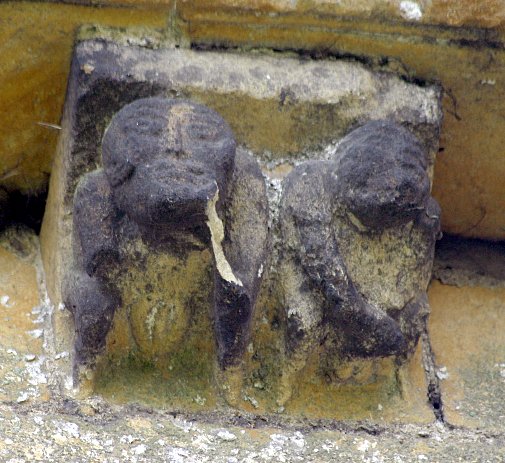
The Figures
These figures were discovered by Dr Theresa Oakley and Dr Alex Woodcock who published their findings in the paper “The Romanesque Corbel Table at St John’s, Devizes and its Sheela na gig” (The Wiltshire Archaeological and Natural History Magazine Volume 99 2006). The Sheela na gig of the title is one of a pair of exhibitionist figures on a corbel. This makes this corbel the third exhibitionist pair discovered so far in the UK, the other two being at Kirknewton and the window lintel at Whittlesford. There is some argument for the figures at Bredwardine being an exhibitionist pair as well, but the figures are damaged or worn and it is impossible now to tell for certain. This also applies to two figures recently discovered in Norfolk which also may have been exhibitionist.
Both of the Devizes figures are worn and damaged but a lot of detail still remains. The female’s lower right arm is missing and there is recent damage to the left arm which may have originally gestured towards the mouth or cheek (This gesture is similar to the Bredwardine figure and can be seen in many other Romanesque carvings.) The vulva is clearly visible and slightly exaggerated. Interestingly both the pudenda and the inner lips seem to be represented which is unusual.
The male figure is holding his damaged penis in his right hand and angles it away from the female figure, a small pair of testicles can just be determined between the legs. Both figures are angled slightly away from each. One can read too much into this but the male figures on both the Kirknewton and Whittlesford carvings seem to be very much interested in the female figure.
In addition to the exhibitionist pair the corbel table also holds an acrobatic monstrous anus shower. This has a bestial face and holds its legs in the exposing a deeply carved anus. Intriguingly in the photo below there appears to be a suggestion of a possible vulva above the anus making the figure female. Again we should be careful of reading to much into this.
There are many other monstrous corbels including one with a monster devouring a human figure head first with only the legs visible and a pair of human figures hugging each other inside a monsters mouth.
Given that a lot of newly discovered figures are equivocal it’s good to see a new discovery that are unambiguous exhibitionists. For those interested Dr Oakley’s Phd. thesis on Sheela na gigs will be published soon as a British Archaeological Report and Dr Woodcock’s paper “Liminal Images. Aspects of Medieval Architectural Sculpture in the South of England from the Eleventh to the Sixteenth centuries” is already available.
There is another exhibitionist figure which is widely regarded as a fake held at the museum in Devizes
The underside view of the exhibitionist pair. Both the pudenda and inner lips are depicted which is unusual.
